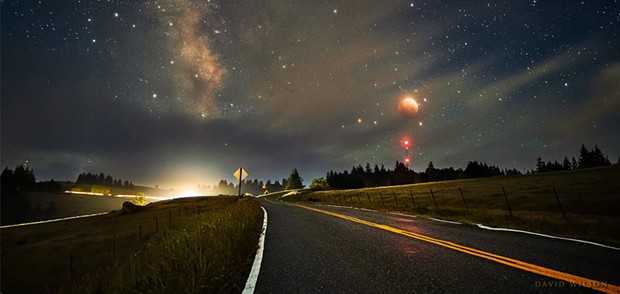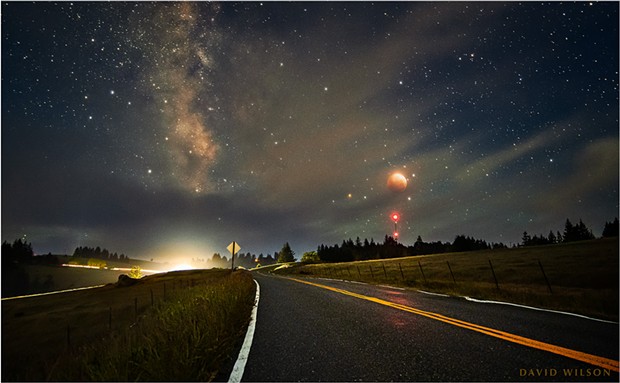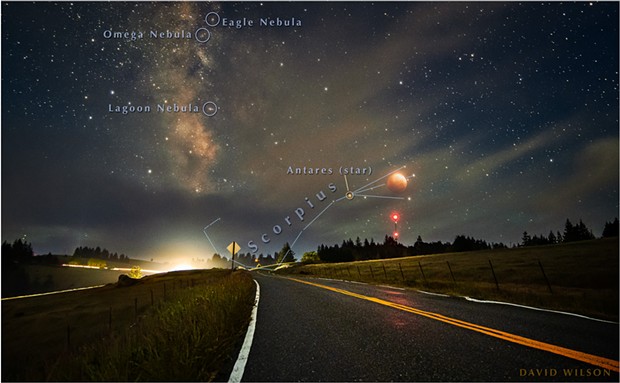Thursday, June 10, 2021
North Coast Night Lights: Eclipse of the Super Flower Moon
Posted By David Wilson on Thu, Jun 10, 2021 at 1:00 AM
The moon’s orbit around Earth is elliptical, a squished circle, which means that sometimes the moon is closer to Earth than at other times. When the full moon coincides with the moon’s closest approach, called perigee, the full moon is called a super moon, and naturally, being closer, it is a slightly larger full moon than otherwise.
Blood Moon is a term referring to the deep reddish-orange that the moon becomes during a total lunar eclipse, which we saw on May 26 this year. A total lunar eclipse such as this occurs when the moon passes directly through the densest part of the shadow that the sun casts behind Earth. The plane in which the moon orbits Earth is offset from the plane about which the Earth orbits the sun, so it isn’t often that Earth, the moon, and sun line up in this way. When the three celestial bodies line up with the moon behind Earth, the moon passes into Earth’s shadow and is eclipsed.
Do you think a photograph is always going to show reality? Or that it has to? Since I began teaching Digital Photography at College of the Redwoods, a beginning class, I’ve noticed a common conception that photographs always show “reality,” and that they capture instants in time. It’s understandable, since this is how we typically use our cameras — to capture and freeze what we saw. The typical photograph does often capture an instant in time and space pretty much the way we saw it, or remember it. It can even become the way we remember it, whether it was exactly how we saw it or not. This makes an interesting topic for discussion in class.
Cameras see the world differently from the way you or I see it, and sometimes what they capture is either beyond what we can see with our own eyes, or else it falls far short of what we see with our own eyes. I call those phenomena the camera’s superpowers and limitations. To have powers beyond ours, while also having limits greater than ours, means that it is possible to capture photographs that do not closely resemble what we saw with our flesh and blood eyes. So which was reality: what we saw, or what the camera saw? I tend to say either or both, for our realities are a matter of perception, and seeing things in new ways is useful.
This image represents both the camera’s amazing superpowers, and its severe limitations. The camera’s superpower here is its ability to see so much better into the low light of night than my naked eye can. It was still the dark of night for me, just enough light cast by the moon to throw a shadow behind me as I watched its face darken and redden. The Milky Way was visible, too, but as always it was fairly faint to the eye, and color on the landscape was almost nonexistent, though I could discern some yellow in the stripe.
Our eyes see the world moment-by-moment, and staring into the night for seconds at a time does not make the night any brighter. But unlike our eyes, the camera’s patient eye in this case gathered light for a full thirty seconds, building up the image lightness and detail with each passing second. The camera’s more patient eye was able to capture the road, landscape, and night sky with far more clarity, detail and color than I could. The sensor’s ISO can be turned way up, too, allowing it to capture even more detail in near darkness. These are superpowers of the camera that can bring us views of the night that we will never see with our naked eyes. It’s still reality.
But what about the moon? It didn’t fare as well in the exposure; it ran into a severe limitation of the camera and became over exposed, which resulted in it not looking the way I saw it at all. To my eye that morning as I photographed beside the road, the eclipsed moon glowed a beautiful amber-red, bright enough to easily see color and detail in it. But to the camera, which was set to capture the much darker landscape and night sky, the lighter moon became a featureless bright white spot in the sky. The camera was not able to capture both the relatively bright eclipsed moon, the dark landscape, and faint Milky Way all at once because the difference in brightness values between the darkest and lightest elements was simply too great. Its superpower of seeing into the darkness did not allow it to see both the dark landscape and bright moon at once, and the moon became too bright.
I wanted to bring home the full eclipse experience that I’d had, with the moon appearing the way I had seen it, and the Milky Way accompanying it with the landscape visible beneath it. To do so, I made a second exposure in which the moon looked normal. But though the moon looked good in this one, now the sky and landscape were nearly completely black, much darker than even my naked eye had seen it. My solution was to use the moon from that image on top of the too-bright moon in the photo of the landscape and sky, with the result that now my image of the Super Flower Blood Moon eclipse of May 26 more closely resembles what I saw that early morning.
I had to work at it to bring you the eclipse as I’d seen it. A single snapshot couldn’t do it. Some might say I should have left the sky black and had a normal-looking moon surrounded by blackness. Some might say I should have left the moon a bright white spot with the Milky Way and landscape as you see here. Neither of those is what I saw, though. I chose to share this.
To keep abreast of David Wilson’s most current photography or purchase a print, visit or contact him at his website mindscapefx.com or follow him on Instagram at @david_wilson_mfx and on Twitter @davidwilson_mfx . David teaches Art 35 Digital Photography at College of the Redwoods.
Speaking of...
-
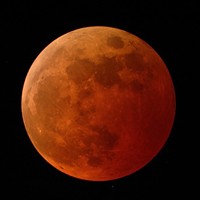
'Blood Moon' Lunar Eclipse Starts Just After Midnight
Nov 7, 2022 -
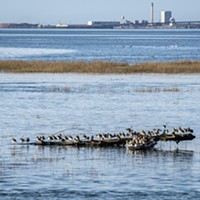
2021 in Pictures
Dec 31, 2021 -
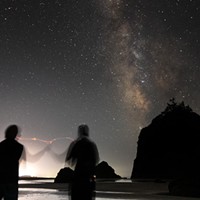
North Coast Night Lights: The One that Got Away
Sep 19, 2021 - More »
Comments (2)
Showing 1-2 of 2
